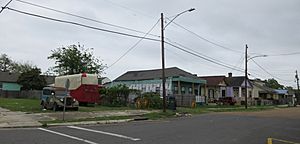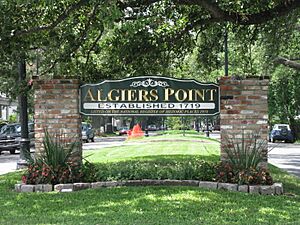Algiers, New Orleans facts for kids
Quick facts for kids
Algiers
15th Ward
|
|
|---|---|
|
New Orleans Neighborhood
|
|

Shotgun houses in Old Algiers
|
|
| Country | United States |
| State | Louisiana |
| City | New Orleans |
| Police District | District 4, Algiers |
| Area | |
| • Total | 0.62 sq mi (1.6 km2) |
| • Land | 0.62 sq mi (1.6 km2) |
| • Water | 0.00 sq mi (0 km2) |
| Population
(2010)
|
|
| • Total | 25,995 |
| • Density | 41,900/sq mi (16,190/km2) |
| Demonyms | Algierene, or Algerine |
| Time zone | UTC-6 (CST) |
| • Summer (DST) | UTC-5 (CDT) |
| Area code(s) | 504 |
Algiers (/ælˈdʒɪərz/) is a historic neighborhood in New Orleans. It is the only part of Orleans Parish located on the West Bank of the Mississippi River. People often call Algiers the 15th Ward, which is one of the 17 Wards of New Orleans. This area is famous for being home to many early jazz musicians. It is also the second oldest neighborhood in the entire city.
Contents
Discovering Algiers' Past
How Algiers Began
Algiers started in 1719, not as a town, but as a large farm called the "King's Plantation." It was first used to store gunpowder for the city. It was also a place where newly arrived people, forced into slavery, were held. Later, it became a stop for the Cajuns who had been forced to leave their homes.
A man named Barthelemy Duverjé helped Algiers grow into a town. It became important for building and fixing ships in its dry docks. It also had many railroad yards. A big fire in 1895 destroyed much of the town around the Courthouse. But Algiers rebuilt itself, much like a phoenix rising from ashes.
In 1870, Algiers officially became part of New Orleans. It was named the 15th Ward. Even though there have been talks about Algiers becoming separate again, it has remained part of the city. Until the late 1930s, train cars were moved across the Mississippi River by large barges. Then, the Huey P. Long Bridge was built upriver. This bridge included a railway, making it easier to move trains.
The largest railroad area was the Southern Pacific yard. People in Algiers still call it "the SP yard." For many years, it was mostly empty land. Some parts of it were used for new homes in the early 2000s. When the yard was busy, a steam-powered train ferry would carry railroad cars from there across the river.
Algiers in the 1900s
In 1901, the U.S. Navy opened a naval station in Algiers. During the early 1900s, Algiers was affected by Jim Crow Laws. These laws in the Southern United States kept Black and white people separate and unequal. Under these laws, Black people were not allowed to live in Algiers Point. This area was meant for white people or Creoles of color who were seen as white.
Black people lived downriver from Algiers Point in an area called McDonoghville. Locals sometimes call it "Over the Hump." This neighborhood was named after John McDonogh. Before he died in 1850, McDonogh created "Freetown" for formerly enslaved people and other people of color. Freetown was renamed McDonoghville in 1815. When Algiers joined Orleans Parish in 1870, McDonoghville became the largest Black community on the West Bank of the Mississippi River. Many famous Jazz artists grew up in McDonoghville in the 1910s. These included Kid Thomas Valentine, Red Allen, and Papa Celestin.
Some of the early Black neighborhoods were Riverview, Tunisbourg, McClendonville, LeBeoufville, Hendeeville, Oakdale, and Whitney. In 1938, L.B. Landry High School opened. It was the first all-Black school in Algiers. The school was named after Dr. Lord Beaconsfield Landry, who lived in the area and died in 1934. It was also one of the first schools in New Orleans to serve African Americans.
Around the 1930s and early 1940s, more schools and neighborhoods were built for Black residents. These included Peter S. Lawton School and Oakdale. Oakdale was once on the edge of Jefferson Parish. It stretched from Whitney Avenue to the Mississippi River. It was torn down in the late 1950s to make space for the Greater New Orleans Bridge.
Newton Street became the center of Algiers's Black community. It used to have many ballrooms, saloons, and Juke joints. Popular places like Kohlman's Tavern, Ping Pong Club, and Whitney's Ballroom drew hundreds of people every weekend. The most famous spot, Greystone Voter's League, hosted Rhythm & Blues shows. Great singers like Ray Charles, Son House, and B. B. King performed there. Most of the jazz clubs in Algiers closed by the 1970s.
Algiers began to change as new neighborhoods were built. These new areas expanded along Gen. Meyer and Gen. De Gaulle. Many white families from older parts of the city started moving into these new sections of Algiers. Behrman Heights was built to house military families of all races. It became the first neighborhood where people of different races lived together. Aurora and Walnut Bend subdivisions remained mostly white. The oil industry created many jobs and helped businesses grow.
In 1970, New Orleans Public Schools opened a second high school, O. Perry Walker. This school was named after Oliver Perry Walker, a former superintendent who supported segregation. In the early 1970s, many white families started moving out of Behrman Heights. This happened after the Housing Authority of New Orleans opened the Christopher Park Homes for low-income Black families. This led to a movement called White flight. This meant many white families left the area. This also caused many businesses to leave Algiers for other neighborhoods in nearby Jefferson Parish.
Algiers' Culture
Algiers has been home to many important jazz musicians. These include Red Allen, Peter Bocage, George Lewis, Papa Celestin, and Kid Thomas Valentine. Jazz musicians in the 1920s called Algiers the "Brooklyn of the South." They used this name because it was close to New Orleans, just like Brooklyn is close to New York City, with a river separating them.
Algiers also has a long history of Brass bands. The Algiers Brass Band is one of the oldest traditional brass bands still playing in the city. There were several community halls where early jazz was played. These included Algiers Masonic Hall, the Elks Hall, and the Ladies of Hope Benevolent Hall. Today, you can still see some jazz parades in the neighborhood.
Algiers has several nicknames, like A.L.G. and 1.5. But locals most often call it the "Westside of New Orleans" or simply "Westside."
Who Lives in Algiers?
Algiers is mostly African American. In the 2000 Census, about 89.4% of residents identified as African American. Before Hurricane Katrina, the total population of Algiers was 28,385 people. About 45.9% were male and 54.1% were female. The average age was 29.6 years old.
In Algiers Point, about 21.8% of the people are white, and 73.6% are African-American. A small number, 0.2%, are Native Americans and Alaskan Natives. Latino/a people make up 4.3% of the population. The average household has 2.68 people.
Many people in Algiers have finished high school (72.3%). About 14.3% have at least a bachelor's degree.
Neighborhoods in Algiers
Algiers is made up of many different neighborhoods, such as:
- Algiers Point
- McDonogh
- Old Aurora
- New Aurora
- Lower Algiers (Cutoff, River Park)
- Whitney
- Behrman
- Fischer Housing Development
- Tall Timbers/Brechtel
- McClendonville
- Christopher homes project
Learning in Algiers
Schools for All Ages
Schools in Algiers are part of the Orleans Parish School Board (OPSB), also known as New Orleans Public Schools (NOPS). The main office for the district is in the Westbank area of Algiers.
Here are some of the schools in Algiers:
- Martin Behrman Elementary School (Kindergarten to 8th grade) - Algiers Point
- Dwight D. Eisenhower Elementary School (Kindergarten to 8th grade) - Tall Timbers/Brechtel
- William J. Fischer Elementary School (Kindergarten to 8th grade) - Fischer Development
- McDonogh #32 Elementary School (Kindergarten to 8th grade) - McDonogh
- L.B. Landry High School - Old Algiers
- O.P. Walker High School - Old Algiers
Other schools are run by different groups:
- InspireNola Charter Schools operate:
- Edna Karr High School - Old Aurora
- Alice M. Harte Elementary School (Kindergarten to 8th grade) - Old Aurora
- Crescent City Schools include:
- Harriet Tubman Charter Elementary School
- Paul B Habans Elementary School
One campus of the International School of Louisiana (ISL) is also located in Algiers.
Famous People from Algiers
Many notable people have connections to Algiers, including:
- Henry "Red" Allen, jazz trumpeter and singer
- Joe Blakk, rapper
- Corey Calliet, trainer and actor
- Peter Bocage, jazz trumpeter and violinist
- Gary Carter, Jr., politician
- Papa Celestin, jazz trumpeter
- J. Lawton Collins, World War II general
- Frankie Duson, jazz trombonist
- G-Slimm, rapper
- Alvin Haymond, retired NFL player
- Rich Jackson, former NFL defensive end
- Anthony Johnson, NFL defensive tackle
- Cee Pee Johnson, jazz drummer and vocalist
- Freddie Kohlman, jazz drummer
- George Lewis, jazz clarinetist
- Kendrick Lewis, NFL free safety
- Lance Louis, NFL offensive guard
- Manuel Manetta, jazz musician
- Memphis Minnie, blues singer and guitarist
- Jimmy Palao, jazz musician
- Malik Rahim, Black Panther Party member and activist
- James Ray, basketball power forward
- Cyril Richardson, NFL guard
- Virgil Robinson former NFL running back
- Lou Sino, jazz trombonist and singer
- Herb Tyler, college quarterback
- Kid Thomas Valentine, jazz trumpeter and pioneer of the Preservation Hall Jazz band
- Mike Wallace, NFL wide receiver
- Eddie Bo, singer
- Joe Thomas, jazz clarinetist
- Lester Young, jazz saxophonist
- Bobby Mitchell, singer
- Herman Riley, jazz saxophonist
- Jim Robinson, jazz trombonist
- Clarence "Frogman" Henry, rhythm and blues singer
- Tom Albert, jazz violinist and trumpeter
- Shawn Wilson, politician


